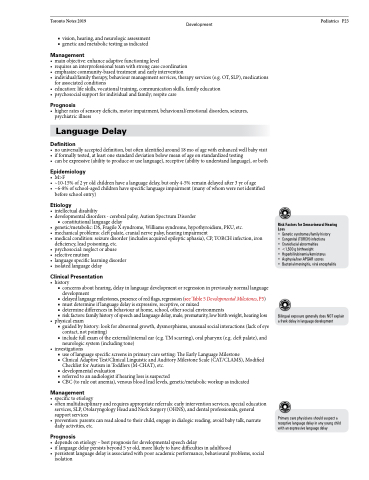Page 1057 - TNFlipTest
P. 1057
Toronto Notes 2019 Development ■ vision, hearing, and neurologic assessment
■ genetic and metabolic testing as indicated
Management
• mainobjective:enhanceadaptivefunctioninglevel
• requiresaninterprofessionalteamwithstrongcasecoordination
• emphasizecommunity-basedtreatmentandearlyintervention
• individual/familytherapy,behaviourmanagementservices,therapyservices(e.g.OT,SLP),medications
for associated conditions
• education:lifeskills,vocationaltraining,communicationskills,familyeducation • psychosocialsupportforindividualandfamily;respitecare
Prognosis
• higherratesofsensorydeficits,motorimpairment,behavioural/emotionaldisorders,seizures, psychiatric illness
Language Delay
Definition
• nouniversallyaccepteddefinition,butoftenidentifiedaround18moofagewithenhancedwellbabyvisit • ifformallytested,atleastonestandarddeviationbelowmeanofageonstandardizedtesting
• canbeexpressive(abilitytoproduceoruselanguage),receptive(abilitytounderstandlanguage),orboth
Epidemiology
• M>F
• ~10-15%of2yroldchildrenhavealanguagedelay,butonly4-5%remaindelayedafter3yrofage
• ~6-8%ofschool-agedchildrenhavespecificlanguageimpairment(manyofwhomwerenotidentified
before school entry)
Etiology
• intellectualdisability
• developmentaldisorders-cerebralpalsy,AutismSpectrumDisorder
■ constitutional language delay
• genetic/metabolic:DS,FragileXsyndrome,Williamssyndrome,hypothyroidism,PKU,etc.
• mechanicalproblems:cleftpalate,cranialnervepalsy,hearingimpairment
• medicalcondition:seizuredisorder(includesacquiredepilepticaphasia),CP,TORCHinfection,iron
deficiency, lead poisoning, etc.
• psychosocial: neglect or abuse
• selectivemutism
• languagespecificlearningdisorder
• isolatedlanguagedelay
Clinical Presentation
• history
■ concerns about hearing, delay in language development or regression in previously normal language
development
■ delayedlanguagemilestones,presenceofredflags,regression(seeTable5DevelopmentalMilestones,P5)
■ must determine if language delay is expressive, receptive, or mixed
■ determine differences in behaviour at home, school, other social environments
■ riskfactors:familyhistoryofspeechandlanguagedelay,male,prematurity,lowbirthweight,hearingloss
• physicalexam
■ guided by history: look for abnormal growth, dysmorphisms, unusual social interactions (lack of eye
contact, not pointing)
■ include full exam of the external/internal ear (e.g. TM scarring), oral pharynx (e.g. cleft palate), and
neurologic system (including tone) • investigations
■ use of language specific screens in primary care setting: The Early Language Milestone
■ Clinical Adaptive Test/Clinical Linguistic and Auditory Milestone Scale (CAT/CLAMS), Modified
Checklist for Autism in Toddlers (M-CHAT), etc.
■ developmental evaluation
■ referred to an audiologist if hearing loss is suspected
■ CBC (to rule out anemia), venous blood lead levels, genetic/metabolic workup as indicated
Management
• specifictoetiology
• oftenmultidisciplinaryandrequiresappropriatereferrals:earlyinterventionservices,specialeducation
services, SLP, Otolaryngology Head and Neck Surgery (OHNS), and dental professionals, general
support services
• prevention:parentscanreadaloudtotheirchild,engageindialogicreading,avoidbabytalk,narrate
daily activities, etc.
Prognosis
• dependsonetiology–bestprognosisfordevelopmentalspeechdelay
• iflanguagedelaypersistsbeyond5yrold,morelikelytohavedifficultiesinadulthood
• persistentlanguagedelayisassociatedwithpooracademicperformance,behaviouralproblems,social
Pediatrics P23
Risk Factors for Sensorineural Hearing Loss
• Genetic syndromes/family history
• Congenital (TORCH) infections
• Craniofacial abnormalties
• <1,500 g birthweight
• Hyperbilirubinemia/kernicterus
• Asphyxia/low APGAR scores
• Bacterial meningitis, viral encephalitis
Bilingual exposure generally does NOT explain a frank delay in language development
isolation
Primary care physicians should suspect a receptive language delay in any young child with an expressive language delay


